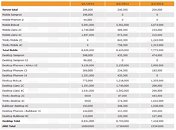Monday, November 19th 2012

APUs Make Up Nearly 75% of AMD's Processor Sales
Despite losing in market share to Intel, AMD has reason to cheer as its APU gambit is beginning to pay off. According to the latest architecture- and core count-specific sales figures for AMD given out by Mercury Research detailing Q3-2013 in context of two preceding quarters, APUs make for nearly 75% of AMD's processor sales, and the company's recently-launched "Trinity" line of desktop and mobile APUs are off to a flying start.
The most popular chips in AMD's stable are its "Bobcat" Zacate series low-power APUs, which are being built into entry-level computing devices such as netbooks, nettops, and all-in-one desktops. The chips make up 39 percent of AMD's sales in Q3, followed by another APU line, the A-Series "Trinity", which is available in desktop and mobile variants, offers a combination of a fast integrated graphics processor with up to four CPU cores, and makes up 26.1 percent of AMD's sales. AMD's A-Series "Llano" can still be bought in the market, and makes up 7.4 percent of AMD's sales in Q3.The picture is rather dull over at AMD's non-APU processor lineup, based on Bulldozer and K10/10.5 architectures. Vishera numebrs are not included in the research, as they are very recently launched. Despite being the older architecture, AMD's K10/K10.5 architecture, which makes up Phenom II series processors, outsold Bulldozer by nearly two times. Non-APU processor make up a little over a fourth of AMD's sales. Given this, it wouldn't be far-fetched to think that AMD is better off consolidating its resources to developing its APU line.The research even included AMD's sales (in units, not revenue) across the desktop, server, and mobile lines. While the desktop and mobile lines are evenly matched, the server line has an insignificant 1.3 sales percentage. The finer numbers are tabled above.
Source:
3DCenter.org
The most popular chips in AMD's stable are its "Bobcat" Zacate series low-power APUs, which are being built into entry-level computing devices such as netbooks, nettops, and all-in-one desktops. The chips make up 39 percent of AMD's sales in Q3, followed by another APU line, the A-Series "Trinity", which is available in desktop and mobile variants, offers a combination of a fast integrated graphics processor with up to four CPU cores, and makes up 26.1 percent of AMD's sales. AMD's A-Series "Llano" can still be bought in the market, and makes up 7.4 percent of AMD's sales in Q3.The picture is rather dull over at AMD's non-APU processor lineup, based on Bulldozer and K10/10.5 architectures. Vishera numebrs are not included in the research, as they are very recently launched. Despite being the older architecture, AMD's K10/K10.5 architecture, which makes up Phenom II series processors, outsold Bulldozer by nearly two times. Non-APU processor make up a little over a fourth of AMD's sales. Given this, it wouldn't be far-fetched to think that AMD is better off consolidating its resources to developing its APU line.The research even included AMD's sales (in units, not revenue) across the desktop, server, and mobile lines. While the desktop and mobile lines are evenly matched, the server line has an insignificant 1.3 sales percentage. The finer numbers are tabled above.


46 Comments on APUs Make Up Nearly 75% of AMD's Processor Sales
I guess AMD could always do that if this new architecture proves to be problematic over the medium term.
I said when the APUs first came out, it'll take Intel till at least gen 3 or 4 to catch up to APUs. That is looking to come true. 4000 series did better than I expected against Llano but still lagged behind. I do expect them to finally beat Llano with Haswell. But it would take a good investment from Intel to catch up to AMD's lead designs. Unless they decided to buy nVidia, it would take Intel awhile to compete toe to toe with APU graphics.
If Intel buys nV, I'm mortgaging my house to buy AMD stock. :D
They've invested so much money on manufacturing, releasing and marketing Bulldozer as the way forward it would be pointless wasting all that energy and resources to go backwards.
They need to press forward with Piledriver and Steamroller, move to 28 nm node and keep tweaking it.
If it was 2011 I would have loved to see a Phenom II on 32nm, but that boat has gone.Probably, but the longevity wouldn't last long. That architecture was tweaked out! From Athlon 64, Athlon II X2, Phenom, Phenom II. They even made a last ditch refinement with the Phenom II X6 where they managed to add two extra cores without compromising the TDP. The restricted die space means they couldnt do much apart from add more cache tighter latencies but that would only give a slight performance boost.
In the end consumers get rewarded!!
Only my friends buy 4/6/8core monsters with high end GPU's to play the latest and greatest games.
Secondly, the jump in performance between Intel's previous and current IGPs may have been large, but that's so easy when your starting point is pure crappiness. There comes a point of exponentially increasing complexity and diminishing returns, and that's where the process starts to be time-consuming. There is no way around it.
Thirdly, AMD's mistakes with the Athlon 64? I'm sorry, but AMD forced Intel to abandon the Netburst architecture and take the Pentium Pro (P3) architecture back from the mothballs and tweak it to make the first Pentium M and Core CPUs, forced Intel to use the AMD64 instruction set for 64-bit computing, in short, AMD did everything, technology-wise, to take the lead from Intel.
But Intel had so much money, so much manufacturing capacity, and AMD had so little, if you remember correctly at the height of A64 popularity, AMD was selling its chips at complete manufacturing capacity and THAT is what prevented them from gaining additional market share. AMD hardly made any mistakes back then. No, the only reason Intel took back the lead from AMD is all their years of illegal monopoly practices, harming AMD, who couldn't expand when the time was right.
If AMD hadn't been harmed by Intel's illegal practices, they would have been able to expand production back then, and they would have gotten perhaps 30% of the CPU market instead of the 15% they have today. More money, more sales, would have meant more resources for engineering the following generation, but they had to do with what they had, and that wasn't enough. The first Phenoms were weak, and Intel took the lead back from them.
I don't see where AMD went wrong in any of the decisions back then, and I was following things very closely.
Even where you are saying that the consumer gets rewarded isn't right, given that Intel has been stifling competition rather than behaving legally. Consumers have been harmed by this. I wonder if a class action lawsuit would be doable LOL. Meh, it's too long ago now, however, it cannot be argued, if you look at the situation objectively, that consumers don't continue to be harmed today by Intel's monopolistic and illegal practices over the last 20 years.
However, I will say that the bigger the company, the bigger the potential for problems, money issues, bribery, illegal & unethical business practices, etc....
I had a friend (he is no more now) who worked for Intel and he used to tell how efficient the whole process of making a CPU or chipset etc that Intel can build a brand new working prototype in days not years. You don't need 10000 minds to think, you only need few brains to think and make the rest work on those lines. Their prototyping methods and skills were top notch.
I am sure other companies have similar or better process. But with Intel's capacity, money and resources if they want they can produce a good GPU, heck they can now hire all the laid off brains from ATI (AMD), form a new division and create a new GPU line.
After all these years they have tried to dive head first into the GPU industry with ridiculous claims of performance numbers only to fall short of their own expectations on the prototype, or whatever stage the thing was in at the time of revealing it (talkin' about Larabee). Unless Intel has it's own dedicated team to handling discrete graphics that has nothing to do with Intel hardware (CPU, MB, SSD, etc..), then we will see Intel's GPU division to flourish and bump heads with the big boys on that front. But that will never happen because of Intel's ego.
I disagree, this isn't when AMD failed. Merely outperforming the competition isn't enough to gain market share, this is evident as AMD's performance lead was from 2001-2006 and it didn't much to benefit them. In 2006, my friends didn't know whom AMD was. You need to market your product and be able to supply it to a greater reach or audience which AMD are doing. Now in 2012 even my non technical friends have at least heard of AMD despite it's performance.
The truth is, if AMD wanted to release something that could outperform i7 they could do it at any point. It comes down to is it financially feasible as far as development, manufacturing, marketing etc?This part I agree with.
Both AMD and Intel can develop CPUs/GPUs/APUs very quickly. Maybe not days. But they've got enough backlog of research to put stuff together within a short period of time.
It seems that AMD sales are off in first gen Llano and Bobcat. New gen Trinity and even Bulldozer shows growth. But the deficit is only 3.3 million units. Now, consider 5-6 million units for PS4 APU sales and the same for XBOX 720 or whatever sales add to that WiiU GPU sales and the outlook does not appear that gloomy.
The console design wins could generate $0.5 Billion easily.
Here are the numbers.
Xbox 360 to date 70 million units since 2005. = 10 million units per year. Oban APU
PS3 70.2 million since 2006 = 11.7 million units per year. A10 APU
Wii 97 million since 2006 = 13.8 million units per year. HD7000 gpu at $10 per this alone is $138 million.
Game consoles more than make up for any present short fall. Surprisingly all console makers are reporting growth in current sales.